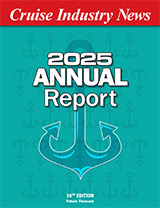Carnival Corporation reported net income $381.8 million or $1.35 per share on revenues of $1.81 billion for its fiscal year ended Nov. 30, 1994, compared to net income of $318.2 million or $1.13 per share on revenues of $1.56 billion in 1993.
The company carried 1,354,000 passengers in 1994 for a load factor of 104 percent compared to 1,154,000 passengers and a 105.3 percent load factor in 1993.
The increases for the year were primarily attributed to additional capacity and increased revenue yields for the company’s entire fleet. The additional capacity resulted from Carnival Cruise Lines’ Sensation and Fascination which entered service in November 1993 and July 1994, respectively, and Holland America Line’s Maasdam and Ryndam which started operations in December 1993 and October 1994. respectively.
At press time, Carnival also ordered its eighth Fantasy-class vessel from Kvaerner Masa-Yards, scheduled for delivery in 1998.
Carnival Cruise Lines will now have one new ship entering service in 1995; two in 1996; none in 1997; and two in 1998. In addition is HAL’s fourth Statendam-class vessel entering service in 1996.
Stronger Margins
Carnival Corp. boosted revenues and earnings along with its net income margin from 20.4 percent in 1993 to 2.1 percent for 1994.
While revenue per passenger day was $222.90 in 1994, up only 58 cents over $222.32 in 1993, net income per passenger day was up $1.27 or 2.8 percent from $45.44 in 1993 to $47.12 in 1994.
1995
Looking forward to 1995, Carnival Corp. expects an approximate 13 percent increase in capacity over 1994 resulting from a full year of service of Carnival’s Fascination and HAL’s Ryndam, along with the delivery of Carnival’s Imagination scheduled for July I995.
Arison also said that winter bookings for Carnival Cruise Lines’ fleet were strong, but that booking momentum industry-wide for the winter, especially for cruise lines in the premium segment of the market, showed weakness. He indicated this development has affected HAL’s winter bookings.
Additionally, both cruise lines are committed to increased advertising spending in the ftrst quarter and for all of 1995 in anticipation of three new ship deliveries in 1996. As a result of both these factors, Arison stated, the ability of Carnival Corp. to grow its earnings during the fiist quarter of 1995 may prove difficult.
Arison added, however, that bookings for HAL’s summer programs in Alaska and Europe have remained strong and, “if this trend continues, it should help Carnival Corp. reach its earnings objectives for 1995.”
Fourth Quarter
Carnival Corp. reported net income of $70.1 million or $.25 per share on revenues of $410.6 million for its fourth quarter ended Nov. 30, 1994, compared to net income of $50.1 million or $.18 per share on revenues of $325.7 million for the fourth quarter of 1993. (The per share data were adjusted to reflect a two-for-one stock split effective Nov. 30, 1994.)
Carnival reported that its fleet carried 327,000 passengers in the fourth quarter of 1994 for a load factor of 100.9 percent compared to 252,000 passengers and a 100.9 percent load factor in the fourth quarter of the previous year.
Friction
While Carnival Corp. is sailing “full-steam ahead” here, there are reports that Carnival’s venture with Epirotiki Lines may be heading for the rocks. If that turns out to be true, Carnival’s long planned entry into the promising European market may once again suffer a setback.
Sources cited differences between the no-nonsense American business-style of President Pam Conover and the Greek family-way of operating.
Carnival first announced plans to enter Europe jointly with Club Med.



